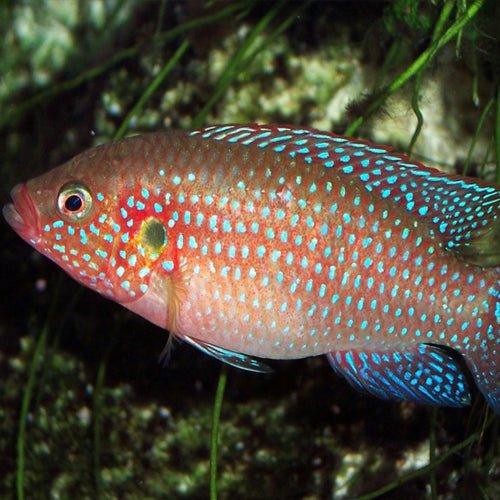Scientific Name: Hemichromis bimaculatus
Please note – The image used above is for illustration purposes only; Size, colour and sex may vary. Many of our livestock species are sold as juveniles and have not yet reached their full size and colour potential. If you have any concerns about the size or colour of the livestock you wish to order, please contact our livestock team via our support centre before placing your order. Due to the large quantities of livestock orders daily, the livestock team will are unable to select fish / shrimp to meet specific gender or aesthetic needs.
Approximate purchase size : 3.5 - 5cm
All Pond Solutions will always endeavour to supply as close to the approximate size range as possible. Due to variations from suppliers on rare occasions this may not always be possible. Images used are to show the full potential of the fish when fully mature and are not always representative of juvenile specimens.
How easy are they to care for?
These are an easy level of care.
How large can they grow?
15cm
Where in the world are they from?
Widespread throughout Africa's western coast in most river systems from Guinea to Liberia.
What is the ideal number to keep together?
Will happily exist in groups as juveniles, but when mature should only be kept in pairs. As with other dwarf cichlids, purchasing a group and then allowing a pair to naturally form is preferable to purchasing 2 on their own as this can result in 2 x Male or 2 x Females.
What water conditions do they require?
Temperature ranges of 22 - 29 Celsius and will accept pH ranges between 6.0 - 7.5
What should you feed them?
Will happily accept most foods.
How compatible are they with other fish?
Should be kept in a medium to large community set up including Congo Tetras and Larger Barbs.
Can they be bred in captivity?
Yes, however this species can get incredibly aggressive when spawning so caution is advised. Their colouration however is best seen when spawning as they will turn a brilliant red. As previously stated best to purchase a small group and let them pair off naturally. Otherwise spawning is quite common and easily achieved as long as substrate sites are provided.









